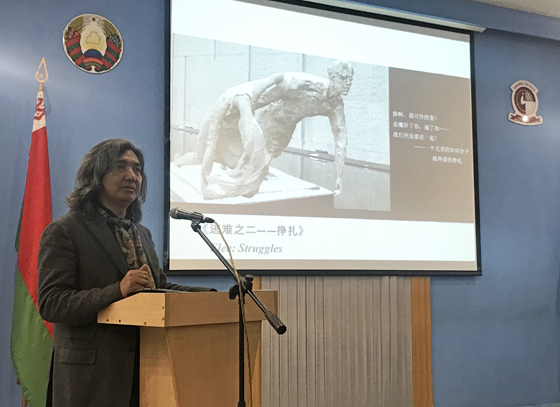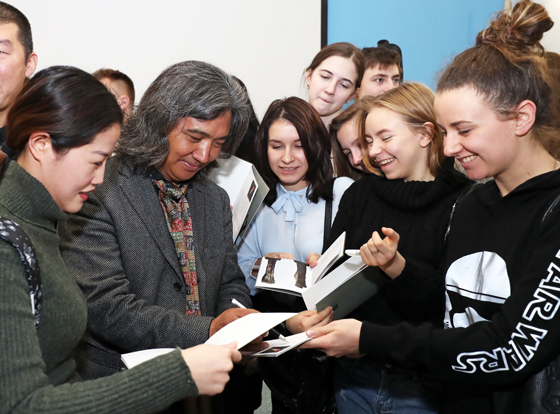NAMOC Director Wu Weishan Expounded on Thematic Creation for Nanjing Massacre in Belarus and Ukraine on National Memorial Day
Source:: Time:2017年12月20日
In the morning of December 13, 2017 (local time in Belarus) and in the afternoon of December 14 (local time in Ukraine), in order to commemorate the 80th Anniversary of Nanjing Massacre and China’s Fourth “National Memorial Day”, NAMOC Director Wu Wushan, at the respective invitation of Belarusian State University of Arts and Culture and the Chinese Embassy in Ukraine, held a keynote speech entitled “Cultural Perspective of Sculpture and a Community of Shared Future for Mankind” in Academic Lecture Hall of Belarusian State University of Arts and Culture and Conference Hall of the Chinese Embassy in Ukraine. More than 200 teachers and students from various departments of Belarusian State University of Arts and Culture and about 80 guests listened to his speech, including Viktor Kiktenko (President of the Ukrainian Association of Sinology), Chernevski (Secretary General of the Ukrainian Artists Association), Gallatin (Professor of National Technical University of Ukraine), representatives from the Ukrainian Parliament, Ministry of Culture and Ministry of Foreign Affairs, professors and student representatives from Taras Shevchenko National University of Kyiv, Kyiv State Linguistic University and Ukrainian Academy of Arts, representatives from Xinhua News Agency and the Ukrainian media, as well as staffs of the Chinese Embassy in Ukraine. Chinese Ambassador to Ukraine Du Wei presided over the speech.
Mr. Wu Weishan began with his artistic creation course and thought, followed the clue of universal feeling—Sleeping Child, all-inclusive philosophy—Lao Tzu, harmonious culture—The Confucius, the wise man’s innermost words—Exploration for Doctrine and transcendental time and space—Dialogue, and reviewed his incisive reflections over artistic creation and the value of life.
According to him, an artist's creation not only focuses on aesthetical art, but also depends on culture and thought. Without the macroscopic thought of man, community of shared future for mankind and common values, such art can only be described as an insignificant skill, with merely scarce and feeble vitality and emotional expression. On this basis, the lecture shifted to the core content of the entire keynote speech, namely, “The Appeal for Peace—Spiritual Connotation of Thematic Group of Sculptures in The Memorial Hall of the Victims In Nanjing Massacre By Japanese Invaders”. In heavy mood, Mr. Wu Weishan explained his feelings when he created this group of sculptures from 2006 to 2007.
This group of carvings is respectively themed with “Ruined Family and Death”, “Fleeing from National Calamity” and “Shout from Victimized Ghosts”, makes retrospect to the darkest and most painful memories of the Chinese history and the Chinese Nation drenched with bloody tears in the 20th century. Part of “Ruined Family and Death” portrays a humiliated mother whose child is dead. She is also a symbol of the war-ridden motherland. She looks sorrowful and has spasms in both legs. But she still stands on the Chinese land. Her sorrow and cry make visitors understand fragile and helpless human life and despair in face of brutal war. Part of “Fleeing from National Calamity” highlights the panic and fear when fleeing from devil's clutches and vanishing hope for life after families are dispersed and dead. The last part of “Shout from Victimized Ghosts” consoles the victims in the context of heartbreaking death and a hell on earth. Mr. Wu Weishan emphasized: “This abyss of bitterness, suffered by the Chinese people, is actually laden by the whole mankind because shared destiny of the mankind is closely interwoven!”
According to Mr. Wu Weishan, he often look up materials and references in archives and libraries, interviewed witnesses and victims of Nanjing Massacre, visited scholars and experts engaged in historical studies on of Nanjing Massacre. He was determined to erect a historic monument for the Chinese Nation on the basis of authentic historical materials! This was what he should do as an artist, a Chinese and a person with upright human nature! He always advocates “highlight soul with literary mind” and “mirroring history with mind”. When he created this group of sculptures, he was motivated by reflections over the moterhland, the Chinese nation, history, time, soul and spirit. Anybody cannot be separated from human nature, which manifests the meaning of life justifying the basic factors to be a human being in his opinion.
Furthermore, in the creation process of this group of epic masterpieces, Mr. Wu Weishan wrote a poem entitled “The Grievance Beyond Words” with his indignant mood. This poem is an accurate portrayal of the compassionate humanitarian spirit demonstrated by this group of sculptures by bemoaning the state of the universe and pitying the fate of the mankind. This poem is often cited to describe this history on the occasion of national memorial ceremony. Mr. Wu Weishan finally ended his bold speech with this poem: “I have no words to express grieved feeling in recalling that bloody storm. I pacify 300,000 victimized ghosts with my trembling hands. I engrave the suffering of the Chinese Nation with many untold hardships with my pure heart. I pray, and I expect the awakening of our ancient nation—Rise of the Spirit!!!”
In Q & A Session, a female student of Belarusian State University of Arts and Culture asked a question about the pessimistic and sad emotion expressed by Thematic Group of Sculptures in The Memorial Hall of the Victims In Nanjing Massacre By Japanese Invaders, as she often found the heroic Chinese soldiers in film and television productions. Mr. Wu Weishan answered that history is a mirror and needs to be kept in mind all the time. This not only constitutes a part of Chinese people’s historical memory at present, but also motivates China and the Chinese Nation to forge ahead and advance bravely. Belarus and Ukraine also suffered from havoc and turmoil raging everywhere and fought against the aggressors during the Second World War. Three countries share the common and equally painful historical memory. In addition to the Chinese, the Belarusians and the Ukrainians, the whole mankind prays for peace and continuously addresses a lot of challenges from the perspective of history and reality. However, we are confident of triumphing over difficulties, prevailing in dangerous situations and eliminating threats of a new war, as shared destiny of all people has been firmly interlinked. Mr. Wu Weishan pointed out: “As artists, we must have awareness of historical reflection, and devote to peace and prosperity. The Chinese, the Belarusians and the Ukrainians should join hand for this purpose. To this end, all people should make united efforts”.



